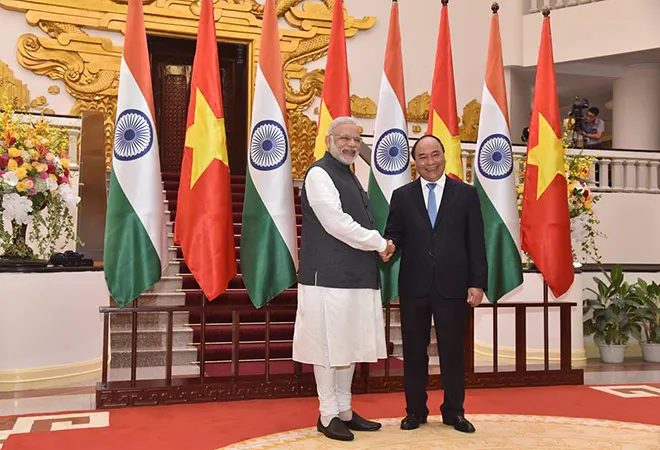India puts great emphasis in developing closer economic ties with the Association of South-East Asian Nations (ASEAN)because the region is a major hub of manufacturing activities and its share in global output, foreign direct investments, exports, and imports have grown consistently. Within the ASEAN, Vietnam, a small country with a population of only 95.4 million persons, is an export powerhouse and has often been dubbed as a miracle economy. Its gross national income per capita (in PPP terms) trebled from $2,160 in 2000 to $6,460 in 2017 and there was a massive reduction in poverty (at $1.90 a day) from 38% to 2% during the same period.
The country has achieved enormous economic success in the last few decades on account of a booming manufacturing sector. It is currently the third-largest garments exporter after China and Bangladesh with an export turnover of over US$ 30 billionand has emerged as the preferred choice of electronics and mobile phone companies trying to move out of China due to the US-China trade war.
Indian investments are much smaller in magnitude as compared to other Asian countries like China, Japan, and South Korea and only a handful of large Indian firms such as ONGC Videsh, Marico Industries, TATA Groupetc dominate India’s portfolio.
India and Vietnam have historically shared friendly relations and India enjoys substantial goodwill in the country. In 2016, the Strategic Partnership between the two countries was upgraded to Comprehensive Strategic Partnership. Defence ties form the bedrock of India’s relations with Vietnam because of convergence in strategic interests and mutual concerns about China but economic relations remain much below potential. India’s total trade with Vietnam currently stands at about US$ 12.2 billion. Meat and fish products are India’s largest export items to Vietnam and electrical machinery and equipment are India’s main import items from Vietnam. India currently ranks 27th among all foreign investors in Vietnam with a total investment capital of US$ 756 million. Indian investments are much smaller in magnitude as compared to other Asian countries like China, Japan, and South Korea and only a handful of large Indian firms such as ONGC Videsh, Marico Industries, TATA Groupetc dominate India’s portfolio.
India has undertaken several initiatives in recent years to boost its economic ties with Vietnam under the Mekong-Ganga Cooperation and its engagement with the CLMV (Cambodia, Laos, Myanmar, and Vietnam) sub-region. Several delegations from India have also visited Vietnam to explore investment opportunities and held consultations with Vietnamese officials to develop closer ties in the textiles and garments industry. Such efforts have not met with much success. This is largely because the Indian textile and garments industry is in bad shape. Many Vietnamese officials and researchers interviewed by this author during her field work, revealed that textiles and garments industry is not an appropriate sector for collaboration between India and Vietnam because the Indian textile sector is not globally competitive. India’s product quality is not at par with other countries and Indian firms typically fail to meet the tight schedule of the value chain. Given the importance of the textile sector in India’s organised sector employment, this is bad news.
To facilitate Indian investments in the CLMV countries in the manufacturing sector and help Indian companies get integrated with the regional value chains, the Indian government set up the Project Development Fund worth Rs 500 crore in 2016. This was undoubtedly the most important initiative by the Indian government but many analysts have expressed their anguish over the operationalisation this fund. Also, data from the EXIM Bank reveals that so far only one project, the possibility of setting up a pharmaceutical manufacturing unit, has been identified in Vietnam. Textiles and manufacturing sector, one of the main sectors in which India sought to engage with Vietnam has been ignored.
Although defence cooperation is an essential component of India’s relations with Vietnam, this project has suffered from many delays.
India’s development cooperation strategy in Vietnam has also not been very helpful in promoting India’s economic engagements in the country. The Exim Bank of India has extended concessional credit lines worth US$ 691 million to Vietnam for various infrastructure projects. The largest project is the US$ 500 million credit line to procure defence equipment from India. Although defence cooperation is an essential component of India’s relations with Vietnam, this project has suffered from many delays. One of the main reasons behind the delay is Vietnam’s concern about its rising public debt. The country’s current public debt-to-GDP ratio is about 63.9% which is close to the ceiling of 65%. Moreover, Vietnam finds India’s lines of credit programme unattractive because of the relatively higher rate of interest of 1.75% and the mandatory procurement of 75% of the materials from India. The country can access funds from China, Japan, and South Korea at much cheaper rates.
With an underperforming manufacturing sector, sluggish export growth, and job losses in the manufacturing in the last couple of months, business as usual can not be an option for India. To achieve the target of increasing manufacturing share in GDP to 25%, India needs to learn from the experience of other countries in Asia like Vietnam which have industrialised very rapidly in a short of time and get integrated into regional value chains because over three-quarters of global trade takes place through value chains. India should also try to make its development cooperation more effective and make sure that instruments lines of credit deepen India’s economic engagements with partner countries like Vietnam. In a nutshell, stronger strategic partnership with Vietnam is good news but we also need stronger economic partnership with Vietnam.
This commentary originally appeared in The Economic Times.
The views expressed above belong to the author(s). ORF research and analyses now available on Telegram! Click here to access our curated content — blogs, longforms and interviews.




 PREV
PREV


